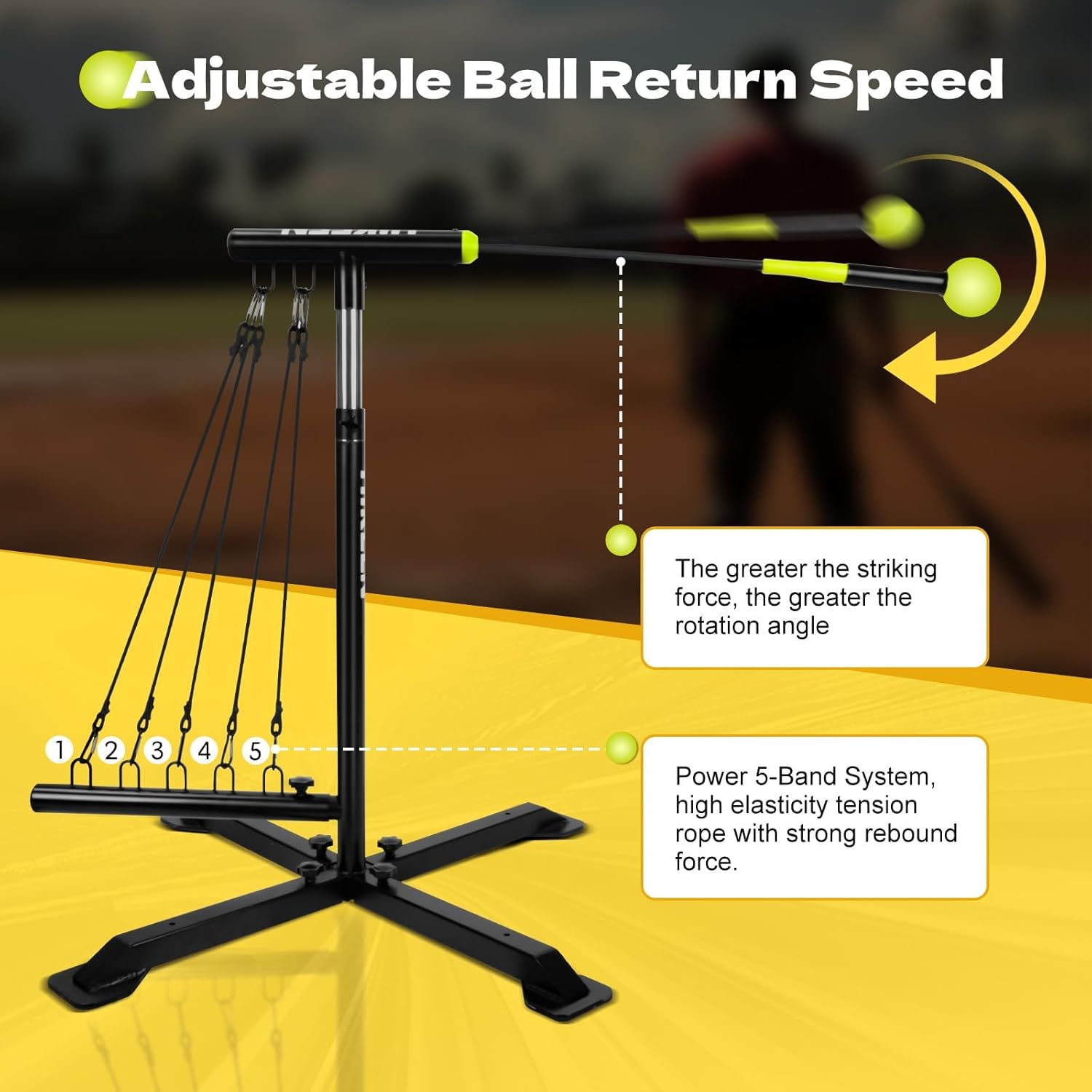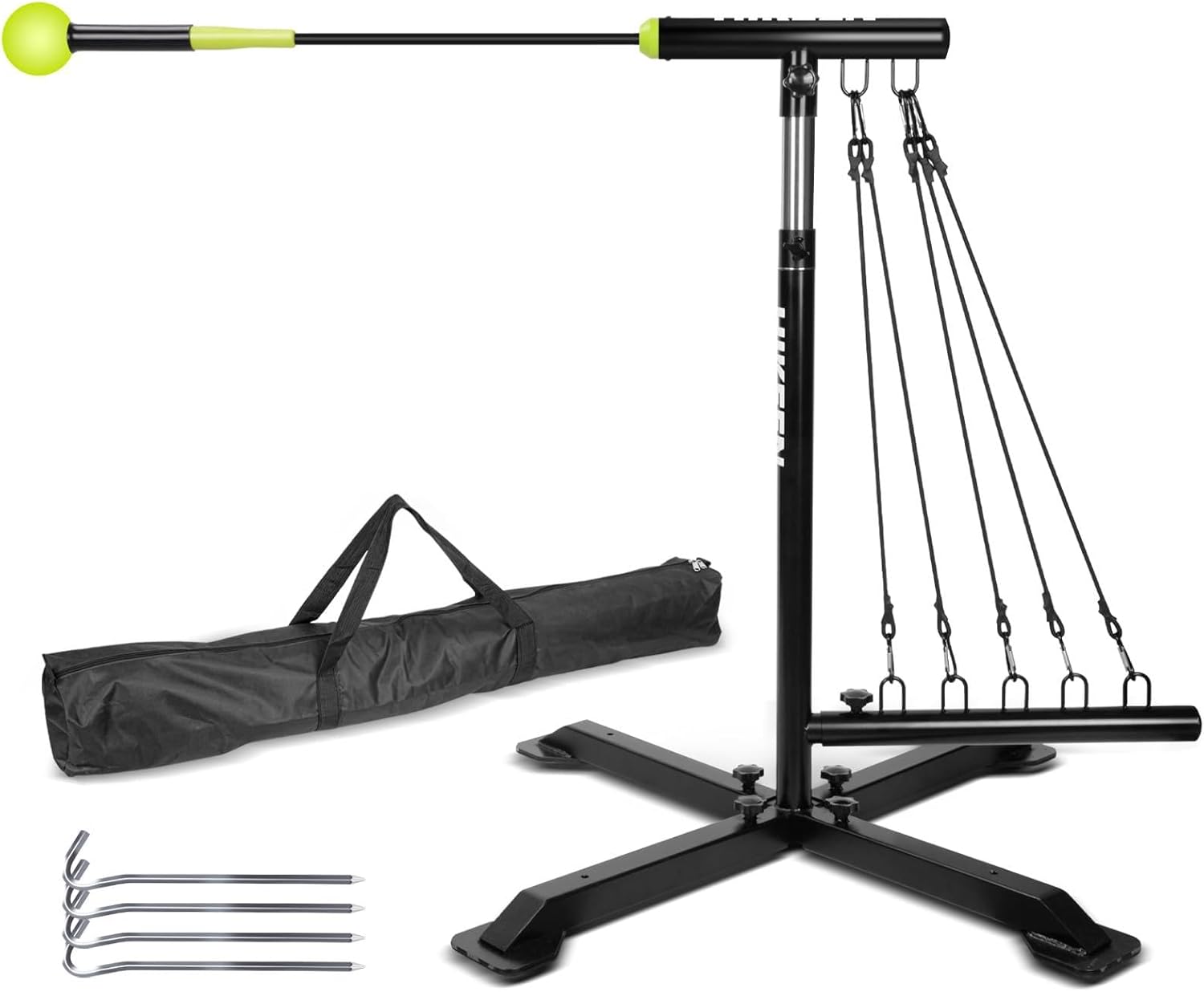Every hitter has been there: you step into the batter’s box full of confidence, but once you connect, the ball dribbles weakly toward the infield. Or worse, you swing wildly, missing pitches you know you should crush. Inconsistent mechanics, poor timing, and weak wrists undermine even the best intentions. Hours in the cage can feel wasted if you aren’t reinforcing the correct swing path, hip rotation, and hand positioning. Without targeted feedback, bad habits—casting the bat away from your body, rolling your wrists too early, or failing to engage your lower half—become entrenched. The result is frustration, decreased performance, and a stalled progression that leaves you longing for a reproducible path to a tighter, more powerful swing.
In this article, you’ll learn how the Baseball Softball Swing Trainer—an elastic-resistance, adjustable training aid—solves these challenges by guiding proper swing mechanics and encouraging the muscle memory every hitter needs. You’ll discover why resistance training transforms your natural motion into a potent, repeatable tool, how to adjust the trainer for youth through adult players, and best practices to integrate it into your regular practice regimen. With the right drills and consistent use, you’ll groove a swing that’s smooth, efficient, and engineered for extra-base hits.
Shop Baseball Softball Swing Trainer

How Resistance Transforms Your Swing Mechanics
Traditional batting practice relies on repetition with a live or tee ball—but without real-time feedback, hitters can continue reinforcing flawed movements. The Baseball Softball Swing Trainer changes the dynamic by integrating elastic resistance bands attached to a secure anchor. As you swing, the bands apply force opposing your bat path. This resistance highlights inefficiencies—if you cast your hands too early, the band will yank your barrel off plane; if your hips fail to rotate fully, you’ll feel the strain. Over time, your body learns to overcome this resistance by keeping the bat on a direct, level path through the hitting zone while driving your pelvis through contact. Resistance training isn’t about making your swing harder—it’s a biofeedback mechanism that guides your muscles toward the correct sequence of load, coil, and release.
Because the Swing Trainer’s bands are adjustable, you can start with light resistance to groove the basic path, then gradually increase tension as your mechanics sharpen and your strength builds. For younger players, the lowest setting encourages smooth acceleration without overwhelming developing muscles. High school and college athletes can crank the bands tighter—mimicking the feeling of driving the bat head through thicker air—so that when they remove the trainer, the real bat slices through the zone with explosive speed. Rather than mindlessly lacing chunk after chunk, you’re engaged in mindful practice, feeling exactly when you lose the proper barrel plane or under-rotate your hips. This intentionality accelerates learning curves, helping hitters at every level transition from awkward repetition to precise, powerful swing execution.
Setting Up and Adjusting for Your Ideal Tension
One of the Swing Trainer’s greatest assets is how intuitively it adapts to the user. The unit consists of two anchor attachments—one for a tee or fence, another for a sturdy pole or net frame—and a pair of elastic cords with quick-release carabiners and an ergonomic bat loop. Here’s how to dial in the perfect setup:
- Choose Your Anchor Point: Securely clip one end of the trainer to a fence post, batting cage net frame, or heavy-duty tee stand at roughly chest height. The stability of your anchor is critical—a loose attachment will absorb force instead of providing helpful resistance.
- Attach to Your Bat: Slide the bat loop over your bat’s handle, positioning it just below your top hand. The carabiner prevents slippage during rotation. Ensure the loop sits snugly without restricting your grip.
- Set Resistance Level: The Swing Trainer arrives with three band tensions—light, medium, and heavy. For initial groove work, use the light band: this allows full range of motion while still providing corrective feedback. As you refine your path, switch to medium to build power, then heavy to maximize bat speed development.
- Fine-Tune Anchor Height: Adjusting the anchor up or down by a few inches changes how the elastic opposes swing levels. A slightly higher anchor reinforces a level, slightly upward barrel path, while a lower one accentuates a slight downward plane—helpful for hitters struggling to keep barrel angle through the zone.
- Test and Tweak: Before taking full swings, perform a few slow “air swings” to ensure the resistance feels uniform, and you can maintain a consistent follow-through. If the band pulls you off balance, lower the tension or reposition the anchor until the resistance challenges without compromising form.
With these adjustments dialed in, the Swing Trainer becomes a personalized coach—offering resistance that aligns with your strength and swing cues that highlight areas needing correction. Over successive sessions, you can ratchet up resistance as your bat path and core rotation improve, creating a progressive overload model akin to weight training—but specific to the rotational, explosive movement of the baseball or softball swing.

Drills to Build Muscle Memory and Bat Speed
Consistency and power emerge from ingrained muscle memory, and the Swing Trainer excels at accelerating this process. Here are three foundational drills to integrate into each practice:
- Slow-Motion Path Drill
- Objective: Feel the correct swing plane and hand path.
- Execution: With the light band, assume your normal stance and slowly rotate through the swing in 5–7 seconds, focusing on keeping the bat trace direct from load to contact position. The elastic will pull if you deviate, instantly alerting you. Perform 10 repetitions per side (right- and left-handed if applicable) before moving to full speed.
- Explosive Load-and-Drive Drill
- Objective: Power development through hip rotation.
- Execution: Attach the medium band. From your set position, pause briefly at full load (hips coiled, bat tip pointing up). Then explode through contact, driving your hips forward and extending your arms. The band won’t stop your swing but will slow your barrel if you fail to rotate fully. Complete 8–10 swings, emphasizing rapid hip clearance and balanced finish.
- Follow-Through Finish Drill
- Objective: Consistent extension through the hitting zone.
- Execution: Using the light or medium band, focus less on speed and more on locking out your finish. Swing through a simulated pitch and hold your hands high and extended as if watching the ball fly. The band’s pull reinforces maintaining extension rather than collapsing your arms early. Perform sets of five, feeling the tension at full extension before resetting.
By rotating these drills—always starting with slow, form-focused swings and graduating to explosive motions—you engrain the correct sequence of load, rotation, and release. The elastic bands magnify each error, so you correct early and avoid drilling flawed mechanics.
Shop Baseball Softball Swing Trainer
Integrating the Trainer into Regular Practice
To reap lasting benefits, consistency is key. Here’s how to weave the Swing Trainer into your weekly routine without overtraining:
- Warm-Up Inclusion: Spend five minutes using the Swing Trainer as your dynamic warm-up before live batting practice or tee work. This primes the neuromuscular system for the proper path.
- Alternate Days: Limit heavy-band explosive sessions to no more than two or three times per week, pairing them with rest or light days to allow muscle recovery. On alternate days, perform slow path drills with the light band for maintenance—even on off-field days.
- Combine with Live Hitting: After dedicated trainer work, take a handful of live swings off a tee or soft-toss; you’ll immediately notice the smoother path and increased bat speed. This immediate transfer reinforces the benefits.
- Monitor Fatigue: Pay close attention to signs of overuse—wrist soreness, shoulder tightness, or lower back strain. If you feel excessive fatigue, reduce resistance or volume. The goal is quality repetitions, not sheer quantity.
Over a 6–8 week cycle, hitters who commit to structured Swing Trainer usage often report measurable gains: quicker bat head speed, more consistent barrels through the zone, and deeper penetration of power to the outfield. By making resistance-based feedback a habit, you fast-track the feel of a textbook swing.

Beyond Mechanics: Mental Benefits of Guided Resistance
While the physical advantages are clear, the Swing Trainer also delivers psychological gains. Resistance feedback builds confidence. When hitters feel that controlled tension tugging at their hands, they learn to trust their own ability to maintain the correct path under duress. This heightened body awareness—kinesthetic feedback—reduces second-guessing at the plate. As you grow accustomed to the elastic correction, you approach live at-bats with an ingrained sense of where your bat should be, leading to more confident, decisive swings.
Further, the guided resistance fosters a growth mindset. Each “snap” of the band when your path deviates becomes an instant coach’s cue, prompting self-analysis and immediate correction. This loop of attempt, feedback, and adjustment is far more effective than blind repetition. Over time, as the band’s corrections become subtle or rare, you gain the satisfaction of seeing your body internalize textbook mechanics—translating that progress into real-game success.
Conclusion
The Baseball Softball Swing Trainer transforms hitting practice by combining adjustable resistance with intuitive feedback, guiding hitters toward a repeatable, powerful swing. Through targeted drills—slow-motion path work, explosive hip-drive sessions, and follow-through finishes—you build muscle memory, increase bat speed, and engrain efficient mechanics. Easy to set up and adaptable for all ages and skill levels, this trainer turns every practice into a high-quality, feedback-driven workout. By integrating resistance-based drills into your routine, you’ll step into the batter’s box with unshakable confidence, knowing your swing is honed for consistently hard, accurate contact. Empower your development, outpace bad habits, and unlock your full hitting potential with the Baseball Softball Swing Trainer.
Shop Baseball Softball Swing Trainer

FAQ
- How often should I use the Swing Trainer each week?
Aim for 3–4 sessions per week: two days focused on slow, form-based drills and one to two days on explosive, power-driven drills. Always include rest or light maintenance days to allow muscle recovery. - Can youth players use the same trainer as adults?
Yes. The adjustable bands (light, medium, heavy) let younger hitters start with minimal resistance. As strength improves, they progress to higher tensions—mirroring adult training protocols on a scale appropriate for their age. - Will the elastic interfere with my timing on live pitches?
The trainer is intended primarily for dry swings. Integrate live pitching or soft toss after drills to transfer the correct path to ball-contact scenarios. You’ll find timing actually improves, as your hands and hips learn the ideal sequence under guided resistance. - How do I prevent the band from tangling during rotation?
Ensure the anchor is positioned directly in line with your swing plane, and keep the band taut but not over-stretched. If tangling occurs, pause and untwist the elastic between reps; frequent practice eliminates most tangles as you refine your plane. - Can I use the trainer indoors?
Yes—especially in batting cages or indoor training facilities with sturdy posts or poles for anchors. Ensure the band has clear space around you for rotation, and use lighter resistance to prevent excessive recoil in confined spaces. - Is it safe for older athletes with joint concerns?
The trainer’s elastic resistance is low-impact, but if you have existing wrist, elbow, or shoulder injuries, start with the light band under supervision. Always consult a coach or medical professional before beginning a new resistance training regimen. - How do I clean and maintain the elastic bands?
Wipe bands down with a damp cloth after each session to remove sweat and chalk. Store them away from direct sunlight and extreme temperatures to preserve elasticity. Inspect regularly for nicks or weak spots; replace any band showing visible wear. - Does the trainer work for both baseball and softball bats?
Absolutely. The bat loop fits handles up to 1.2 inches in diameter, covering standard baseball and senior softball bat grips. For youth bats, ensure the loop is snug to prevent slippage during rotation. - How quickly can I expect to see improvements?
Many hitters notice a smoother path and more balanced finish within 2–3 weeks of consistent use. Full bat speed gains and muscle memory retention typically emerge after 6–8 weeks of structured training. - Can I travel with the Swing Trainer?
Yes. The elastic bands and carabiners pack compactly in a duffel or bat bag, and the small anchor clips fit into pockets. Always detach the bands and store them loosely to avoid permanent stretching.











